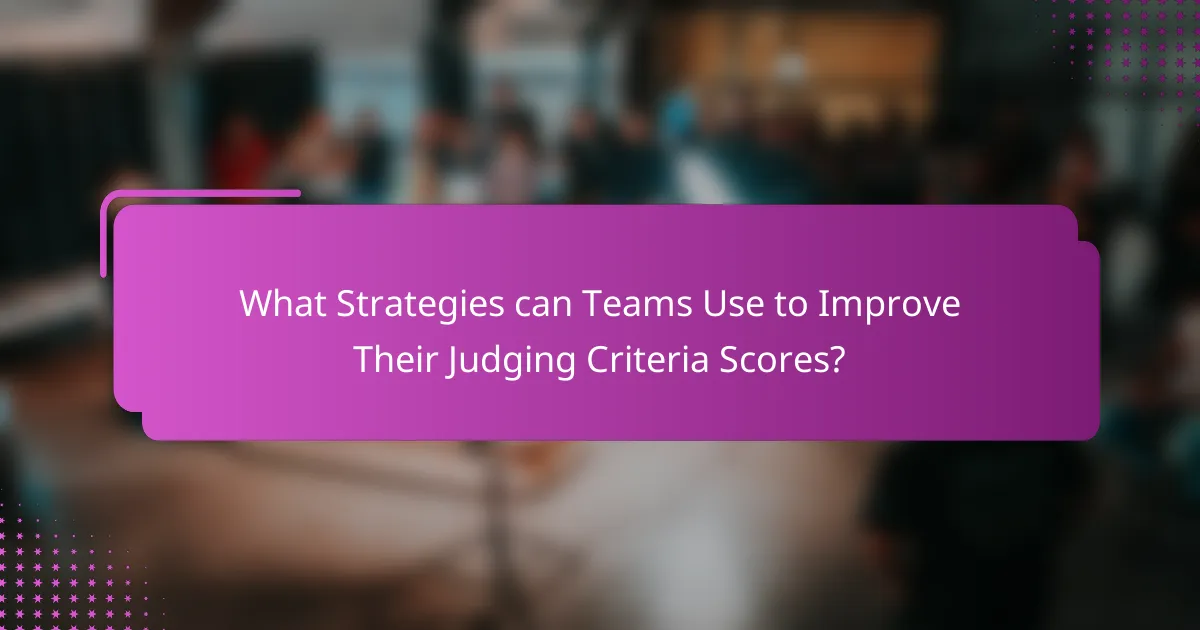The article focuses on the essential judging criteria for student business competitions, which include market viability, team dynamics, and financial projections. Market viability evaluates the potential success of a business idea by examining its relevance to real problems and target audiences. Team dynamics assess collaboration and communication among team members, while financial projections analyze the feasibility of the business model through realistic revenue forecasts and cost management strategies. The article emphasizes the importance of clear communication, data-driven decisions, and effective teamwork in enhancing presentation scores, along with the need for thorough market research and preparation to ensure successful outcomes in competitions.

What are the Essential Judging Criteria for Student Business Competitions?
The essential judging criteria for student business competitions include market viability, team dynamics, and financial projections. Market viability assesses the potential success of the business idea in the marketplace. Judges evaluate whether the concept addresses a real problem and has a target audience. Team dynamics examine how well team members collaborate and communicate. Effective teamwork often leads to more innovative solutions. Financial projections analyze the feasibility of the business model. Judges look for realistic revenue forecasts and cost management strategies. These criteria ensure that participants present well-rounded and viable business proposals.
Why is Market Viability a Critical Criterion?
Market viability is critical because it assesses the potential for a product or service to succeed in the marketplace. This criterion evaluates demand, competition, and target audience. A viable market indicates sufficient customer interest and purchasing power. It also considers market trends and economic conditions. According to a study by Harvard Business Review, 70% of startups fail due to lack of market need. Therefore, understanding market viability is essential for reducing risk and ensuring sustainable growth.
What factors determine Market Viability in a business idea?
Market viability in a business idea is determined by several key factors. These factors include target market size, which assesses the potential customer base. Competitive landscape analysis evaluates existing competitors and market saturation. Customer needs and preferences identify the demand for the product or service. Pricing strategy influences affordability and perceived value. Distribution channels determine accessibility for customers. Regulatory environment examines legal and compliance issues. Financial projections provide insights into profitability and sustainability. Each of these factors plays a critical role in assessing the overall market viability of a business idea.
How can teams assess the Market Viability of their projects?
Teams can assess the market viability of their projects by conducting thorough market research. This research should identify target demographics and analyze competitors. Teams need to evaluate market size and growth potential. Surveys and focus groups can provide valuable customer insights. Financial projections should be created based on realistic assumptions. Teams must also consider regulatory and economic factors that may affect the market. Validating the business model through pilot testing can further confirm viability. These steps collectively ensure a comprehensive understanding of market conditions.
What Role do Team Dynamics Play in Business Competitions?
Team dynamics significantly influence the success of participants in business competitions. Effective collaboration among team members enhances problem-solving and innovation. Teams with strong dynamics communicate openly, leading to better decision-making. Research shows that cohesive teams outperform their counterparts in competitive settings. According to a study by Hackman and Oldham, team dynamics can improve performance by up to 25%. Diverse skill sets within a team also contribute to a more comprehensive approach to challenges. Additionally, positive team dynamics foster motivation and commitment, driving teams to achieve their goals. Overall, strong team dynamics are essential for excelling in business competitions.
How do Team Dynamics influence overall performance?
Team dynamics significantly influence overall performance by shaping communication, collaboration, and trust among team members. Effective team dynamics foster open communication, enabling members to share ideas freely. This leads to enhanced problem-solving capabilities and innovation. Additionally, strong collaboration helps in distributing tasks efficiently, ensuring that each member contributes their strengths. Trust among team members promotes a supportive environment, reducing conflicts and increasing motivation. Research shows that teams with positive dynamics achieve higher productivity and better decision-making. A study published in the Journal of Applied Psychology found that teams with high cohesion outperform those with low cohesion by up to 20%. Thus, the quality of team dynamics is crucial for achieving optimal performance.
What are the key attributes of effective team collaboration?
Key attributes of effective team collaboration include clear communication, trust, and defined roles. Clear communication ensures that all team members understand goals and expectations. Trust among team members fosters a safe environment for sharing ideas. Defined roles help in task allocation and accountability. Additionally, mutual respect and open-mindedness enhance collaboration. Studies show that teams with high trust levels are 50% more productive. Effective collaboration leads to better problem-solving and innovation, crucial in competitive environments.
How are Financial Projections Evaluated in Competitions?
Financial projections in competitions are evaluated based on accuracy, feasibility, and alignment with business objectives. Judges assess the clarity of the projections, including revenue forecasts and cost estimates. They look for realistic assumptions that reflect market conditions. Sensitivity analyses are often reviewed to understand potential risks. Judges also consider the methodology used to create the projections. Comparisons with industry benchmarks are essential for validation. A well-structured financial model enhances credibility. Lastly, the ability to present and defend projections can influence judges’ perceptions.
What components are included in Financial Projections?
Financial projections typically include revenue forecasts, expense estimates, cash flow analysis, and profit margins. Revenue forecasts predict future sales based on market research and historical data. Expense estimates outline anticipated costs, including fixed and variable expenses. Cash flow analysis tracks the inflow and outflow of cash to ensure liquidity. Profit margins measure the difference between revenue and expenses, indicating profitability. These components provide a comprehensive view of a business’s financial future and are crucial for decision-making and attracting investors.
Why are accurate Financial Projections important for success?
Accurate financial projections are crucial for success as they provide a roadmap for a business’s future. They help in setting realistic goals and measuring progress. Financial projections enable businesses to allocate resources efficiently. They also assist in identifying potential financial challenges early. Investors often require accurate projections to assess viability. According to a study by the Harvard Business Review, startups with detailed financial plans are 30% more likely to secure funding. This underscores the importance of financial accuracy in attracting investors. Overall, precise projections guide decision-making and enhance strategic planning.
How do these criteria interconnect to impact competition outcomes?
Market viability, team dynamics, and financial projections are essential criteria that interconnect to influence competition outcomes. Market viability assesses the potential success of a business idea in a real market. It determines if the product or service meets consumer needs and has a viable business model. Team dynamics reflect how well team members collaborate, communicate, and leverage each other’s strengths. Strong team dynamics can enhance creativity and problem-solving, directly impacting the execution of the business plan. Financial projections provide a forecast of revenue, expenses, and profitability. Accurate financial projections are crucial for demonstrating the feasibility of the business model. Together, these criteria create a comprehensive evaluation framework. A strong market viability paired with effective team dynamics and sound financial projections increases the likelihood of a successful competition outcome. Each criterion supports and reinforces the others, leading to a well-rounded presentation that judges are likely to favor.
What are the common pitfalls teams face regarding these criteria?
Teams commonly face pitfalls such as lack of clarity in market viability, poor team dynamics, and inaccurate financial projections. Lack of clarity in market viability leads to misguided strategies. Teams may fail to conduct thorough market research, resulting in unrealistic assumptions about customer demand. Poor team dynamics can hinder collaboration and communication. This often results in conflicts or misalignment of goals among team members. Inaccurate financial projections occur when teams underestimate costs or overestimate revenues. These mistakes can lead to unsustainable business models. Collectively, these pitfalls can significantly impact a team’s performance in competitions.

What Strategies can Teams Use to Improve Their Judging Criteria Scores?
Teams can improve their judging criteria scores by enhancing their presentation skills. Clear communication of ideas is crucial. Teams should practice their pitches multiple times. This helps in refining their message and delivery. Engaging storytelling can captivate judges and make the presentation memorable.
Additionally, teams should focus on data-driven decisions. Providing concrete evidence supports their claims effectively. This can include market research, financial projections, and case studies. Visual aids like graphs and charts can enhance understanding.
Collaboration within the team is also vital. Diverse perspectives can lead to innovative solutions. Regular feedback sessions can help identify weaknesses. Finally, understanding the judging criteria in detail allows teams to tailor their presentations accordingly. This targeted approach can significantly boost their scores.
How can teams enhance their Market Viability assessments?
Teams can enhance their Market Viability assessments by conducting thorough market research. This involves analyzing target demographics, competitors, and market trends. Utilizing tools like SWOT analysis can help identify strengths, weaknesses, opportunities, and threats. Engaging with potential customers through surveys or focus groups provides direct feedback.
Incorporating financial projections into assessments adds quantitative data to support market viability claims. Teams should also evaluate the scalability of their business model. Reviewing case studies of similar businesses can offer insights into market entry strategies.
Validating assumptions with data from credible sources strengthens the overall assessment. According to a study by the Harvard Business Review, data-driven decisions lead to better business outcomes.
What research methods can be employed to validate Market Viability?
Surveys and questionnaires can be employed to validate market viability. These tools gather direct feedback from potential customers. Focus groups provide qualitative insights into consumer preferences and behaviors. Interviews with industry experts can offer valuable perspectives on market trends. Market analysis involves studying competitors and market conditions. A/B testing helps assess consumer reactions to different product offerings. Pilot programs allow for real-world testing of products or services. Each method contributes to understanding market demand and feasibility.
How can teams pivot their ideas based on Market Viability feedback?
Teams can pivot their ideas based on Market Viability feedback by analyzing the data gathered from market research. This feedback highlights consumer needs and preferences. Teams should identify areas where their original concept does not align with market demands. They can then brainstorm alternative solutions or adjustments to better meet these needs. Engaging in iterative testing can refine the new ideas further. Additionally, teams should prioritize features that resonate most with potential customers. Adapting the business model may also be necessary to enhance market fit. Successful pivots are often based on quantitative data and qualitative insights from target audiences. This approach ensures that the revised ideas are more likely to succeed in the competitive landscape.
What practices can strengthen Team Dynamics during competitions?
Effective communication strengthens team dynamics during competitions. Clear communication fosters collaboration and reduces misunderstandings. Regular check-ins keep team members aligned on goals and responsibilities. Establishing roles and responsibilities clarifies expectations and enhances accountability. Encouraging constructive feedback promotes a culture of continuous improvement. Team-building activities build trust and rapport among members. Setting shared goals creates a unified vision and motivates the team. Recognizing individual contributions boosts morale and reinforces team cohesion. These practices collectively enhance performance and synergy during competitive events.
How can teams foster open communication and trust?
Teams can foster open communication and trust by establishing clear communication channels. Regular meetings encourage sharing of ideas and concerns. Active listening promotes understanding and validation of team members’ perspectives. Transparency in decision-making builds confidence among team members. Providing constructive feedback helps improve performance and relationships. Team-building activities strengthen interpersonal connections. Research shows that teams with high trust levels are 50% more productive. Open communication leads to better collaboration and innovation.
What team-building exercises are effective in enhancing collaboration?
Effective team-building exercises that enhance collaboration include trust falls, escape rooms, and collaborative problem-solving activities. Trust falls require participants to rely on each other, fostering trust and communication. Escape rooms challenge teams to work together under pressure, improving problem-solving skills. Collaborative problem-solving activities, such as group brainstorming sessions, encourage diverse input and enhance team dynamics. Research shows that these exercises can significantly improve team cohesion and productivity. A study by the University of Central Florida found that teams engaging in structured team-building activities reported higher levels of collaboration and communication.
How can teams create robust Financial Projections?
Teams can create robust financial projections by utilizing accurate data and thorough analysis. They should begin by gathering historical financial data to identify trends. This data serves as a foundation for future projections. Next, teams must consider market conditions and economic factors that may impact finances. They should also incorporate realistic assumptions about revenue growth and expenses. Utilizing financial modeling tools can enhance accuracy in projections. Regularly updating projections based on actual performance is crucial for reliability. According to a study by the Harvard Business Review, companies that use data-driven decision-making have a 5-6% higher productivity rate. This practice reinforces the importance of data in creating financial projections.
What tools and resources are available for accurate financial modeling?
Excel is a primary tool for accurate financial modeling. It offers robust functionalities for data analysis and forecasting. Many finance professionals utilize Excel for building complex financial models. Additionally, software like Tableau aids in visualizing financial data effectively. Other tools include QuickBooks for accounting and financial reporting. Resources such as Investopedia provide tutorials on financial modeling techniques. Online courses from platforms like Coursera enhance financial modeling skills. Financial modeling templates are also available for streamlined model creation. These tools and resources collectively improve the accuracy of financial projections.
How can teams present their Financial Projections compellingly?
Teams can present their financial projections compellingly by using clear visuals and concise data. Charts and graphs can illustrate trends effectively. Teams should highlight key assumptions that drive their projections. This includes market size, growth rate, and pricing strategy. Providing a narrative that connects the numbers to the business strategy enhances understanding. Teams must also prepare to address potential risks and mitigation strategies. This demonstrates thoroughness and foresight. Engaging storytelling around the data can make the projections more relatable. Finally, practicing the presentation ensures clarity and confidence during delivery.

What Best Practices Should Teams Follow in Student Business Competitions?
Teams in student business competitions should prioritize clear communication and collaboration. Effective teamwork enhances idea generation and problem-solving. Each member should understand their roles and responsibilities. This clarity fosters accountability and productivity. Additionally, teams should conduct thorough market research. Understanding the target audience is crucial for validating business concepts. Financial projections must be realistic and well-supported. Accurate financial planning demonstrates feasibility to judges. Teams should also practice their presentations multiple times. This preparation builds confidence and ensures smooth delivery. Finally, seeking feedback from mentors can provide valuable insights. Engaging with experienced individuals can refine strategies and improve overall performance.
How can teams effectively prepare for judging criteria evaluations?
Teams can effectively prepare for judging criteria evaluations by thoroughly understanding the criteria. Each team should review the evaluation rubric provided by the competition. This rubric outlines specific elements that judges will focus on, such as market viability and financial projections. Teams should then assign roles based on individual strengths to address these criteria.
Practicing presentations is crucial for clarity and confidence. Teams should simulate the judging environment to become comfortable with the format. Gathering feedback from peers or mentors can provide valuable insights for improvement. Additionally, teams should prepare to answer potential questions from judges. This preparation can enhance their ability to articulate their ideas and defend their strategies.
Research indicates that well-prepared teams typically score higher in evaluations. A study by the University of Pennsylvania found that structured preparation leads to better performance outcomes in competitive settings.
What resources are available for teams to improve their presentations?
Teams can utilize various resources to improve their presentations. These resources include presentation software like Microsoft PowerPoint and Google Slides. Online platforms such as Canva offer templates for visually appealing slides. Training workshops focus on public speaking and presentation skills. Books on effective communication provide insights into engaging audiences. Peer feedback sessions allow teams to practice and refine their delivery. Online courses on platforms like Coursera enhance presentation techniques. Video recording tools enable teams to review and critique their performance. These resources collectively enhance the effectiveness and professionalism of presentations.
What common mistakes should teams avoid to enhance their chances of success?
Teams should avoid poor communication to enhance their chances of success. Effective communication helps clarify goals and expectations. Misunderstandings can lead to conflicts and inefficiencies. Teams should also avoid lack of planning. A well-structured plan provides direction and focus. Without it, teams may struggle to meet deadlines. Additionally, teams should avoid ignoring feedback. Constructive criticism can improve ideas and processes. Teams that dismiss feedback risk stagnation. Lastly, teams should avoid underestimating competition. Understanding competitors is crucial for strategic positioning. Acknowledging their strengths and weaknesses can inform better decision-making.
The main entity of the article is the essential judging criteria for student business competitions, specifically focusing on market viability, team dynamics, and financial projections. The article provides a detailed examination of how these criteria impact the evaluation of business proposals in competitions. Key points include the significance of assessing market viability to determine product success, the role of effective team dynamics in enhancing collaboration and innovation, and the importance of accurate financial projections for demonstrating business feasibility. Additionally, it outlines strategies teams can employ to improve their performance in these areas, common pitfalls to avoid, and best practices for preparation and presentation.
